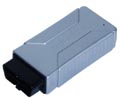- Valve Position Sensor
- |
- Engine Sensors
- |
- Fuel Injection
- |
- Repair Basics
- |
- Technical Info
- |
- Car Tech Info
- |
- MicroTronik
EGR Valve Position (EVP) Sensor

EGR Valve Position Sensor
Operation and Testing
The EGR Valve Position (EVP) Sensor used exclusively by Ford, can be the cause of drivability problems without ever setting any trouble codes. The relationship between the EVP sensor and the EGR valve is important to understand. Either one being out of spec can cause similar symptoms. Understanding this relationship will help you to diagnose uncoded drivability problems like stumbles, hesitations, rough idles and stalling.
First, remember that EGR valves are designed to reduce harmful NOx emissions that may occur when cylinder peak combustion temperatures reach 2500 degrees Fahrenheit. At this temperature, Nitrogen (N), which makes up 78% of the intake air, will combine with Oxygen (O), which makes up 21% of the intake air, in various ratios. The letter (x) represents these various combinations. When NOx enters the atmosphere it unites with hydrocarbons with the help of the sun and smog forms.
Whenever the EGR valve allows exhaust to re-enter the intake manifold it displaces good burnable air/fuel. This cools the combustion but also reduces the power that the cylinders produce. Therefore, we must make sure that this does not happen at the wrong time. The wrong times are:
1) During cold engine operation
2) During engine idle
3) During high power demands
EGR operation during any of these conditions will cause hesitations, rough idle or engine stalling. Today, EGR activity is better controlled by computer operated solenoids and backpressure sensing valves. This greatly overcame the drivability problems of the early EGR systems of the 70s.
The EEC IV system uses the EVP sensor to advance timing and, therefore, help burn the mixture better during EGR flow. The EVP sensor measures the EGR valve position in the same way that the Throttle Position Sensor measures throttle position. As a matter of fact, these electrical circuits work in very much the same way. They both use three wires:
1) 5 volt reference
2) Ground
3) Sensor output to the computer.
They both send a low voltage at closed position and a high voltage at maximum opening. The closed voltage of the EVP depends on the closed position EGR and the maximum voltage of the EVP depends on the position of the EGR when it is at maximum travel. Any position in between minimum and maximum depends on vacuum signal strength and the EGR return spring resistance to the vacuum signal. So, different voltages will be produced by different vacuum signals.
Now, the problem with this chart is that it does not tell you how to move the valve to the opening percentages. The missing information is that Ford EGR valves will open 100% at 8 Hg. Therefore, 50% opening will be obtained by creating 4 Hg, etc.
Now that you know this, you can open the EGR valve using a vacuum pump and watch the voltage on your digital voltmeter with the key on engine off. If you find that the voltage raises more than the chart allows, you probably found the cause for the stumble or hesitation. The EGR valve spring has become weak and it responds too quickly. But, because it is still within the allowed voltage range, there is no trouble code stored. Keep in mind that the EVP Sensor could also be out of calibration or stuck. So when you disassemble the EVP Sensor from the EGR valve you must determine which was at fault. Also be careful to reassemble them with a new (O) ring. This will ensure that a vacuum leak does not occur.
AutoHex (Auto Diagnostic scanner) is one of the best Professional scan tools to for Cars; Autohex Scanner can test the Systems of the Car effectively and easily, with many powerful features to help you in diagnosing and testing.
BMW Key Programming
Description
The following section give some details about EGR Valve Position (EVP) Sensor input to the ECM of the vehicle that contribute towards the desired injector duration.
Autohex II Reviews
AutoHex II
AutoHex II is your best choice to have full access to dealer functions like coding, adjusting and modules flashing/programming, Contact us for prices
AutoHex Forum



